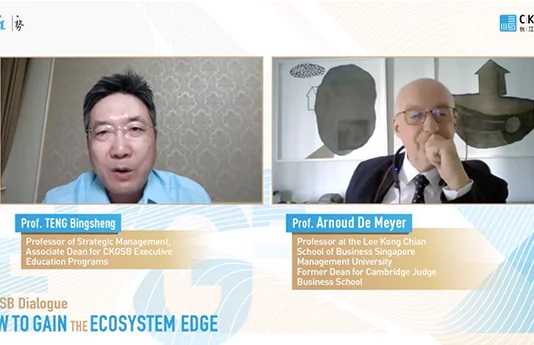Patrick Horgan, Regional Director, North-East Asia, on how Rolls-Royce diversified in China.
Unknown to many, China’s engagement with Rolls-Royce, the iconic British multinational company, goes back nearly a century. In 1919 the first airmail service between Beijing and Tianjin was powered by Rolls-Royce engines on a Handley Page aircraft. In 1963, Rolls-Royce sold Dart engines to the Chinese civil aviation authorities, marking the beginning of a deep relationship with the region. In the early days, along with the sale of aircraft with Rolls-Royce’s engines, pilots and technicians from China went to the company headquarters in Derby for training and familiarization. Today, Rolls-Royce’s engagement with China spans not just aviation, but marine, energy and the civil nuclear industries as well. Greater China is now Rolls-Royce’s third-largest market globally.
Patrick Horgan, Regional Director of North-East Asia for Rolls-Royce, oversees the company’s Greater China business from Beijing. In this interview, Horgan, an old China hand himself [he has worked with various companies in China and Hong Kong since 1989], talks about Rolls-Royce’s portfolio of businesses in China and the way ahead:
Q. Aerospace was the first big industry for Rolls-Royce in China. How did you start off with the others in China?
A. It’s rooted in demand. China’s ship-building industry has really begun to gather pace in the last 20 years. As that happened, we began to develop some manufacturing capacity here: we have a wholly-owned manufacturing facility in Shanghai. We also began to supply to Chinese shipyards. In the first instance, this was typically in response to overseas ship owners. Typically Nordic ship owners were interested in providing to the offshore industry, and other existing marine customers placing orders for marine equipment, for ships using aero/ship design, or using various elements of Rolls-Royce equipment. Then the contract for that was passed to Chinese shipyards as they developed additional capability and began to produce more sophisticated vessels. It was a natural part of the evolution process, and the existing relationships that we had overseas then translated into activity within China. As domestic shipyards become more sophisticated, Chinese ship owners become more sophisticated in their demands. We are also now selling to the Chinese ship owners themselves.
Similarly the key activity in our energy business here is providing mission-critical equipment on the West-East pipeline. So there you have a national project of great significance, bringing natural gas from north-west China and central Asia to the more populated eastern seaboard and coastal regions of China. That’s something that the government and Petrol China cannot afford to fail in. When you build that kind of infrastructure, you want to have equipment that you can rely upon. So we have benefited from the mission-critical nature of the infrastructure which drives demand for the kind of product that we can offer.
Q. How much of Rolls-Royce’s global portfolio is reflected in China?
A. The area of exception is our defense business [because of] the EU arms embargo. Every other part of our business is represented. Civil aviation is a major market for us. [In] energy we provide oil and gas applications in China, the West-East Pipeline Project. We don’t do a great deal in terms of power generation, although we do have some presence there too.
In marine, we are well presented both for the offshore sector and also for more general merchant vessels. And in the civil nuclear sector, we have Rolls-Royce instrumentation and control equipment on an excess of 30 nuclear reactors either already operating or due to be commissioned in China. Over the next 10-20 years, China’s nuclear generation capacity is expected to increase five or six-fold. There will be technology transition during that period, and we hope we can still be a part of the solution.
The largest single business for us in Greater China is civil aviation. The growth in that sector has been huge as domestic travel has blossomed within China, and increasing as more international markets become available for mass Chinese travel. The growth from the 1990s till now has been exceptional. [In] the period from now through to 2031-32, we’re talking about 5,000 additional civil aircrafts entering this market and China going from being the world’s second-largest aviation market to probably becoming the largest in a comparable time frame. This particular area of business for us, and for everybody else involved in China, has been growing rapidly.
Q. What is your assessment of China’s aviation industry and its evolution?
A. The word that first comes to mind when you have this conversation is ‘growth’ and the challenge of meeting that growth, because there has been a great deal of latent demand for air transport in China and connecting China with the rest of the world. The infrastructure, people’s support systems, and the regulatory environment have been running to catch up, or in some cases, there are bottlenecks and impediments of the growth. So everyone thinks about it, the sheer nature of demand here, the challenge that that imposes on the aviation regulator and the airlines, simply in terms of finding sufficient people that are trained and qualified to perform [their] roles. We collaborate closely with the Civil Aviation Administration of China, and help to provide training to equip the next generation of managers in China’s civil aviation. In 18 years we have trained over 1,000 technicians and over 800 management personnel, equipping them with essential skills to help manage this growth period. Clearly, there are other elements that are also constraining factors: for all that China is extremely good at infrastructure and building airports at a tremendous rate, there are [still] infrastructure and air traffic control limitations. When you put all of those things together, you can see a situation where the demand is there and the growth is still there, but there are certain bottlenecks that will have to be addressed for the market to realize its full potential.
Q. The Chinese aviation market is dominated by mostly state-owned carriers. Now that that the ban on private airlines has been lifted, how will it change the dynamics of this market?
A. Airlines in China have changed over the years. There was a period of liberalization still under state-ownership where you had multiple carriers across China, then a period of consolidation where they were grouped into the three larger players [Air China, China Eastern and China Southern] operating from the key hubs in Beijing, Shanghai and Guangzhou respectively. Clearly there was a commitment for those state-owned carriers to become world-class international players. They are already players at scale and they are continuing the development process. I’m sure that the ambition is that they should continue to be successful. There is also some liberalization on the margins. We have seen some fresh arrivals in terms of private carriers and an increased level of discussion around the potential for low-cost carriers. The market doesn’t stand still and we can expect that there will be further change and over time one would expect further liberalization.
At the moment, our core area of focus tends to be in the wide-body aircraft that are servicing the larger domestic region or international routes. And as yet, the private carriers, with the exception of Hainan Airlines which is a special case, are tending to operate single-aisle aircraft. At the moment, compared to the Big Three, plus Hainan, so Big Four, these other players are still relatively small and focused on shorter routes and not yet perhaps our core customer base. But without doubt, there will be further change, liberalization and one would expect an increase in the number of players across China and some new business models emerging as that occurs.
Q. How do you respond to competition from the local industry? In energy, for example, China is now promoting the localization of equipment, such as compressors in natural gas pipeline construction.
A. I have a few things to say on that. Firstly, we have done well in the competitions that we have been involved in. In some cases, there have been awards of equipment to local players, perhaps on a trial basis, to encourage the localization process, but those have not been competed. When there is a competition, we do well. The mission-critical nature of the infrastructure means that you need to look at the reliability, capability and the lifetime operating costs of the equipment. When it’s analyzed in that way, we are quite confident that we do well, especially when you also consider the after-sales servicing dimension of what we can provide there. I don’t think that we run away from competition. In some cases, we don’t get the chance to compete.
We ourselves are localized to a certain extent. We have a global supply chain so that there will be elements of equipment that will be sourced here. And then there are some specific elements of the energy contracts that we fulfilled here that use local partners and suppliers to ensure a degree of local content.
The third thing to mention is that we have also licensed Petrol China to have an after-sales maintenance repair and overhaul facility here in China. So once again, there has been localization of our equipment in terms of the end-to-end servicing of that equipment.
(Watch the video below)
Q. How important is China to the company globally?
A. If you look at Greater China, it’s already generating an excess of £1 billion revenue for us. That equates to 9% [of our total revenues]. It’s our third-largest market globally after the US and the UK, and clearly with great prospect for further growth. China is a priority market for us. That indicates the level of commitment and level of interest of the highest levels within the company.
Q. Is China a significant manufacturing base for you at this point? Do you have any plans to grow it?
A. China is a very significant part of our global supply chain. We have about $200 million [worth] of purchasing annually in China and I would expect that to increase dramatically within the next few years. In particular, we expect that our aerospace, purchasing activities will double within the next five years.
Q. What about research and development on the ground in China? Do you plan to set up a research center of your own?
A. We have a research collaboration initiative with the Institute of Metal Research in Shenyang, which is part of the Chinese Academy of Sciences. That has been running for several years now. We expect we will continue to have research collaboration initiatives in China in the years ahead. We don’t actually have a research center of our own. We operate research through something called university technology centers (UTCs). We have 28 of those globally. Originally they were only in the UK and then progressively we’ve opened up UTC relationships elsewhere in the world. If possible, we may have one here in the future.
Q. At Rolls-Royce, you often have to engage with the government and joint venture partners who are local players. What are some of the lessons that you can share about your experience so far in managing these relationships?
A. People often say that doing business in China is difficult and it’s all about relationships. I’m not sure if I know anywhere in the world where business is not about relationships at one level or another. In China, because of the cultural background, and also because of where China is in terms of its development, they need to foster those relationships. Over time, it’s very important. The need for one’s business activities here to be very clearly in the mutual interest of both parties is very important. So sometimes, you do have to ensure that this is the context in which you are approaching your business and the framework [in] which you are approaching it.
In our case, that is a natural thing to do. Our business is intrinsically a very long-term business, a business where you can’t simply expect to sell the equipment and then walk away. Our business globally is already divided very evenly between services and original equipment sales. So, typically, when we make a sale of original equipment, it merely marks a beginning of a very long-term intimate relationship with our customers. Further, there is a mutual dependency where we have to commit ourselves to very high standards of service to those customers. So, very naturally, you develop this kind of long-term relationship and customer intimacy.
Q. Recently Rolls-Royce has been in the news due to bribery allegations. How do you handle something as sensitive as that, especially in a market like this?
A. There is not a great deal I can say about that beyond what has already been said in the media. Specifically the statement that we have released to the media, which is there is an investigation going on and some other concern in China, Indonesia, and some other markets. Beyond that, there’s really nothing I can say on that issue other than to emphasize the point that our CEO made which is this kind of conduct is in no way tolerable in our organization. There are many steps that we have taken to ensure that these things don’t happen.
Q. What’s next for Rolls-Royce in China?
A. We have to be constantly on the move to keep pace with the change that’s going on here. Our global strategy summarizes [what] we are about. It breaks down to three key elements: customer, innovation and profitable growth.
China is home to many very important customers for us. We have to focus on their needs and make sure what we are providing for them matches, anticipates, and responds effectively to those needs. That will help us to continue to shape what we need to do here
The next element is innovation. There are things that we need to do to recognize a changing profile of demand here and introduce our innovations to our customers who may not have previous experience of them. We see some of that happening: we have our first ‘environship’ under construction in China, a ship that combines a number of different Rolls-Royce elements, a unique wave-piercing bow, Rolls-Royce gas-powered engines and a very sophisticated propulsion systems. Taking all of these elements together, we can reduce CO2 emissions by 40%, comparable to a diesel-powered vessel of a similar time. So, I think that we can see that there are so many things across our portfolio that we can bring to China, adjusting to anticipate customer needs and to introduce fresh innovation that will naturally be positive for us and contribute to profitable growth.




















